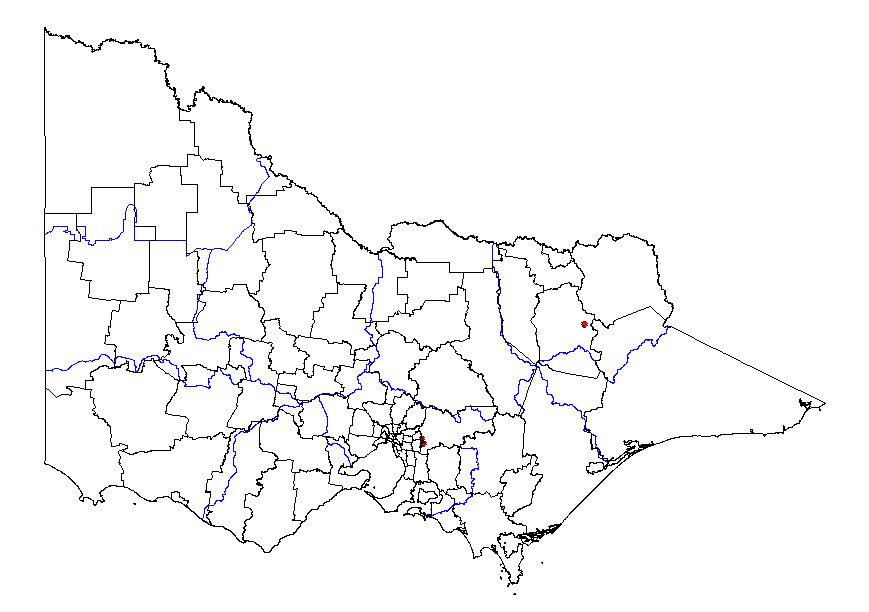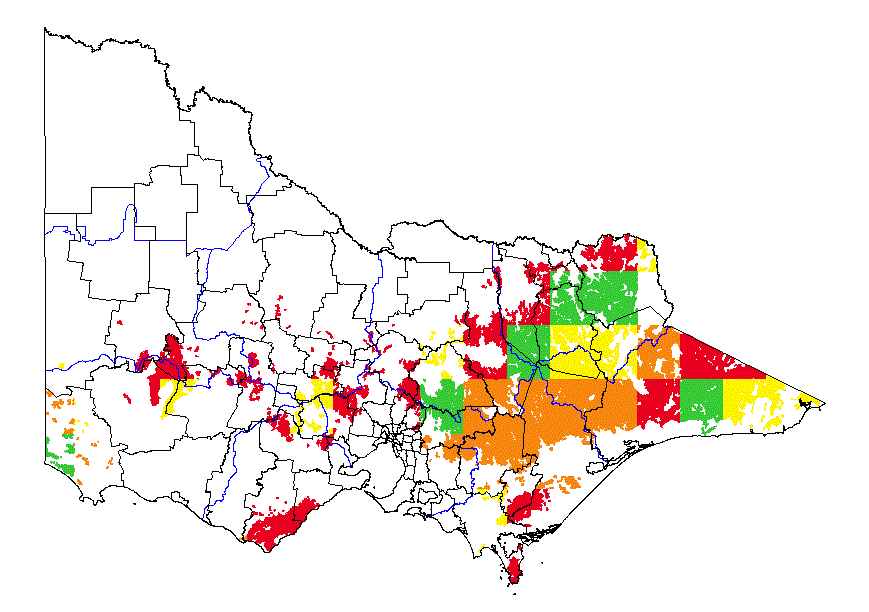Himalayan Strawberry Tree (Cornus capitata)
Present distribution
|  Map showing the present distribution of this weed. | ||||
| Habitat: Cornus capitata grows best at alpine altitudes of greater than 1,000 m; it prefers moist conditions in forested/woodland habitats. It tolerates severe frosts, but not prolonged freezes. | |||||
Potential distribution
Potential distribution produced from CLIMATE modelling refined by applying suitable landuse and vegetation type overlays with CMA boundaries
| Map Overlays Used Land Use: Forest private plantation; forest public plantation; Broad vegetation types Inland slopes woodland; dry foothills forest; moist foothills forest; montane dry woodland; montane moist forest; sub-alpine woodland; riparian forest; rainshadow woodland; alpine woodlands. Colours indicate possibility of Cornus capitata infesting these areas. In the non-coloured areas the plant is unlikely to establish as the climate, soil or landuse is not presently suitable. | 
|
Impact
QUESTION | COMMENTS | RATING | CONFIDENCE |
| Social | |||
| 1. Restrict human access? | Not usually, rarely get a thick stand of trees (Simpfendorfer, ‘92). | L | M |
| 2. Reduce tourism? | Not obvious to ‘average’ visitor; may enhance aesthetics to ‘average’ visitor, especially whilst flowering and fruiting. | L | M |
| 3. Injurious to people? | None mentioned in literature reviewed. | M | L |
| 4. Damage to cultural sites? | None mentioned in literature reviewed. | M | L |
| Abiotic | |||
| 5. Impact flow? | Terrestrial species. | L | M |
| 6. Impact water quality? | No noticeable effect mentioned in literature reviewed. | M | L |
| 7. Increase soil erosion? | Low probability of increasing soil erosion; probably a decrease in erosion likely. | L | L |
| 8. Reduce biomass? | Biomass may increase once tree is semi-matured. | L | L |
| 9. Change fire regime? | Minor change to frequency, or intensity of fire, risk; dependent on the flora replaced. | L | L |
| Community Habitat | |||
| 10. Impact on composition (a) high value EVC | EVC = Swampy Riparian Woodland (V); CMA = Goulburn Broken; Bioreg = Victorian Alp; VH CLIMATE potential. Rarely get a thick stand of trees (Simpfendorfer, ‘92). Minor displacement of some dominant/indicator spp. within any one strata/layer. | ML | M |
| (b) medium value EVC | EVC = Cool Temperate Rainforest (R); CMA = Goulburn Broken; Bioreg = Victorian Alps; VH CLIMATE potential. Rarely get a thick stand of trees (Simpfendorfer, ‘92). Minor displacement of some dominant/indicator spp. within any one strata/layer. | ML | M |
| (c) low value EVC | EVC = Sub-alpine Woodland (LC; CMA = Goulburn Broken; Bioreg = Victorian Alps; VH CLIMATE potential. Rarely get a thick stand of trees (Simpfendorfer, ‘92). Minor displacement of some dominant/indicator spp. within any one strata/layer. | ML | M |
| 11. Impact on structure? | Minor, or negligible, effect on <20% of the floral strata/layers present. Rarely get a thick stand of trees (Simpfendorfer, ‘92). | L | M |
| 12. Effect on threatened flora? | None mentioned in literature reviewed. | M | L |
| Fauna | |||
| 13. Effect on threatened fauna? | May be minor effects by attracting competitive exotics for food source. | ML | L |
| 14. Effect on non-threatened fauna? | Increased effects by changing the food supply. | ML | L |
| 15. Benefits fauna? | Provides an alternate food source, and probably habitat trees. | MH | L |
| 16. Injurious to fauna? | No adverse effect apparent in reviewed literature. | M | L |
| Pest Animal | |||
| 17. Food source to pests? | Yes, animals (inc. birds and mammals) (Blood, ‘01) | ML | M |
| 18. Provides harbour? | No direct mention in reviewed literature, but it may do so. | ML | L |
| Agriculture | |||
| 19. Impact yield? | Not a known weed of agriculture. | L | M |
| 20. Impact quality? | Not a known weed of agriculture. | L | M |
| 21. Affect land value? | Not a known weed of agriculture. | L | M |
| 22. Change land use? | Not a known weed of agriculture. | L | M |
| 23. Increase harvest costs? | Not a known weed of agriculture. | L | M |
| 24. Disease host/vector? | Not a known weed of agriculture. | L | M |
Invasive
QUESTION | COMMENTS | RATING | CONFIDENCE |
| Establishment | |||
| 1. Germination requirements? | Seeds require scarification (cold exposure for 3-4 months) (Plants For A Future website) Evergreen spp. (Blood, ’01) Tree to 12 m. Deep soils (Simpfendorfer, ’92) | MH | ML |
| 2. Establishment requirements? | Not mentioned in literature reviewed. | M | L |
| 3. How much disturbance is required? | Not mentioned in literature reviewed. | M | L |
| Growth/Competitive | |||
| 4. Life form? | Evergreen trees to 15 m (Walsh, et al., ’99) | L | M |
| 5. Allelopathic properties? | None mentioned in literature reviewed. | L | L |
| 6. Tolerates herb pressure? | Yes, relies on fruitivorous behaviours for seed spread. (several, inc. Blood, ’01; Walsh et al. ’99) | MH | M |
| 7. Normal growth rate? | Fast tree growth rate (Simfendorfer, ’92) | H | M |
| 8. Stress tolerance to frost, drought, w/logg, sal. etc? | Tolerates severe frosts (Simfendorfer, ’92) BUT (Jacobson, ’04) Cannot tolerate regions with prolonged freezes. Tolerates marine winds (Plants For A Future website) Resistant to ‘honey fungus’ (Plants For A Future website) NOT drought tolerant (Jacobson, ’04) | MH | M |
| Reproduction | |||
| 9. Reproductive system | Sexual. Fruit in autumn. (Walsh, ‘99) Flowers in early summer (Blood, ’01) Trees in irrigation observed to multiply via vegetative propagation (Jacobson, ’04) Insect pollination (Plants For A Future website) Known to hybridise (Plants For A Future website) | H | M |
| 10. Number of propagules produced? | Not mentioned in literature reviewed. | M | L |
| 11. Propagule longevity? | Not mentioned in literature reviewed. | M | L |
| 12. Reproductive period? | Not mentioned in literature reviewed. | M | L |
| 13. Time to reproductive maturity? | Not mentioned in literature reviewed. | M | L |
| Dispersal | |||
| 14. Number of mechanisms? | Very edible fruit lead to seed spread by birds (Walsh, et al. ’99) and animals (Blood, ’01) Deliberately introduced to Australia as an ornamental (Groves, ’98) widely available commercially (Blood, ’01). Still being recommended for gardening (Burke’s Backyard Website, ’03) | H | M |
| 15. How far do they disperse? | Very likely that propagules will spread > 1 km, via fructivorous behaviour. | H | M |
References
Blood, K. (2001) Environmental Weeds: A Field Guide for SE Australia. C H Jerram Science Publishers. Pg 40.
Botanic Gardens Trust (2006) Cornus capitata www.rbgsyd.nsw.gov.au [Accessed on 27 Sept., ’06.]
Burke’s Backyard. (2003) www.burkesbackyard.com.au [Accessed on 27 Sept., ‘06.]
Cheifetz, A. (Ed’.) (1999) Botanica’s Pocket Trees & Shrubs. Random House, Australia. Pg. 271.
Commonwealth Scientific and Industrial Research Organisation. (1997) CSIRO Australian Weeds. CSIRO Publishing. Pg. 48.
Groves, R.H. and Hosking, J.R. (1998) Recent Incursions of Weeds to Australia 1971 – 1995. Cooperative Research Centre for Weed Management Systems, Technical Series No. 3.
Jacobson A.L. (2004) Plant of the Month. www.arthurleej.com/p-o-m-Jun04 [Accessed on 27 Sept., ’06.]
Plants For A Future (2006) www.pfaf.org/database/plants.php?Cornus+capitata [Accessed on 04 Oct., ‘06]
Randall, R. (2002) A Global Compendium of Weeds. R.G. and F.J. Richardson, Melbourne. Pg. 190.
Simpfendorfer, K.J. (1992) An Introduction to Trees for South-eastern Australia. Inkata Press, Melbourne. Pg. 171-172.
United States Department of Agriculture (USDA). Germplasm Resource Information Network (GRIN). (2006) GRIN Taxonomy for Plants. www.ars-grin.gov [Accessed on 27 Sept., ’06.]
Walsh, N.G. and Entwisle, T.J. (1999) Flora of Victoria; Vol. 4. Inkata Press. Pg. 24.
Global present distribution data references
Australian National Herbarium (ANH) 2006, Australia’s Virtual Herbarium, Australian National Herbarium, Centre for Plant Diversity and Research, [Accessed 25 October, 2006]. http://www.anbg.gov.au/avh/
Global Biodiversity Information Facility (GBIF) 2006, Global biodiversity information facility: Prototype data portal. [Accessed 25 Oct. 2006]. http://www.gbif.org/
Missouri Botanical Gardens (MBG) 2006, w3TROPICOS, Missouri Botanical Gardens Database. [Accessed 25 Oct. 2006]. http://mobot.mobot.org/W3T/Search/vast.html
Feedback
Do you have additional information about this plant that will improve the quality of the assessment?
If so, we would value your contribution. Click on the link to go to the feedback form.


